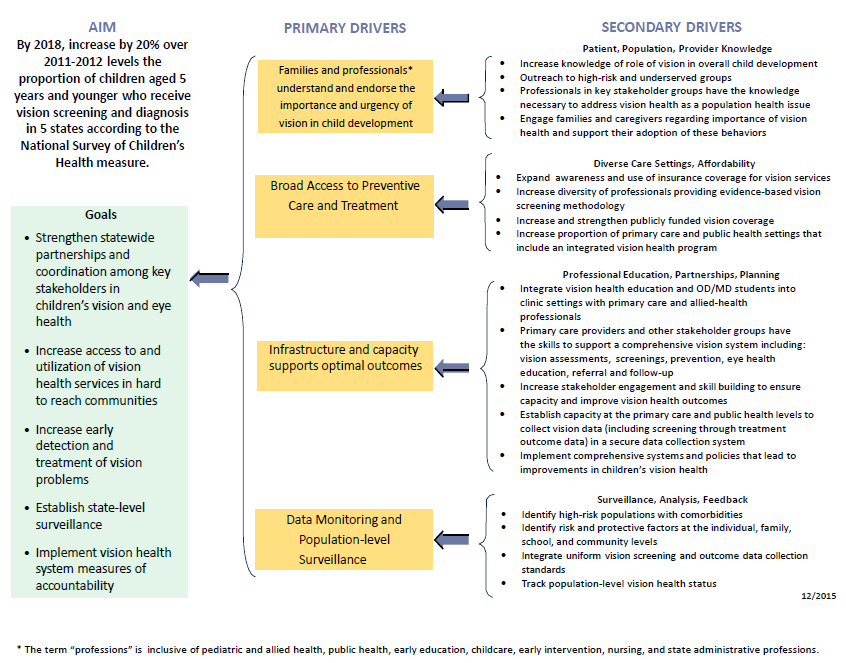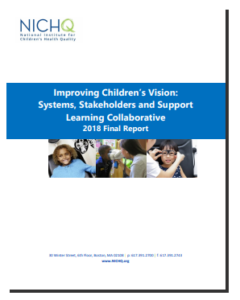The National Center for Children’s Vision and Eye Health at Prevent Blindness (NCCVEH) is pleased to provide the final report on the Improving Children’s Vision: Systems, Stakeholders & Support Collaborative project.
With support from Health Resources and Services Administration Maternal and Child Health Bureau (HRSA/MCHB), the National Institute for Children’s Health Quality (NICHQ) and the National Center for Children’s Vision and Eye Health (NCCVEH) at Prevent Blindness partnered to increase the number of children, ages 0-to-5 years, receiving vision screening, receiving eye care, diagnosis, and treatment through implementation of a quality improvement learning collaborative titled Improving Children’s Vision: Systems, Stakeholders, and Supports (ICV.) This report presents an overview of the methodology, accomplishments and challenges of the ICV learning collaborative and recommendations for future work. Led by NICHQ staff and the NCCVEH, teams in Wyoming, Ohio and Arizona joined three virtual learning sessions and monthly calls where they heard from experts in the field and shared successes and challenges. Through the efforts of state teams, the projects improved early childhood screening systems in primary care practices in Arizona, preschools in Ohio and child development centers in Wyoming.
Background and Goals
The Improving Children’s Vision: Systems, Stakeholders & Support Quality Improvement (QI) Collaborative was a project of the National Center for Children’s Vision and Eye Health at Prevent Blindness (NCCVEH) in partnership with the National Institute for Children’s Health Quality (NICHQ), and the states of Arizona, Wyoming and Ohio. The project’s overall goal was to achieve, in 18 months, improvements in the systems supporting children’s vision and eye health in carefully selected states. From September 2016 through March 2018, the project generated ideas to increase the detection, diagnosis, and treatment of vision problems in children ages 0-5 years old and many of these ideas were tested, implemented and shared. The project employed expert-led QI principles and practices to accomplish the goals. Specifically, the project utilized the framework of the Institute for Healthcare Improvement’s Breakthrough Series™ (BTS) learning collaborative model. This exciting and challenging project required state teams to engage with energy and skill to try new ways of delivering care that supports healthy vision in young children. This initiative increased the early identification of vision problems for young children and is working to ensure that every child receives the eye care they need.
The project employed expert-led QI principles and practices to accomplish the following goals:
- Strengthen statewide partnerships and coordination among key stakeholders in children’s vision and eye health
- Increase access to and utilization of vision health services in hard to reach communities
- Increase early detection and treatment of vision problems
- Establish state-level surveillance
- Implement vision health system measures of accountability
The project, which was completed in August 2018, drew on the wealth of professional and family advocate expertise found in the volunteer Advisory Committee of the NCCVEH. The Advisory Committee includes nationally recognized leaders in children’s health, vision care, public health, early education and childcare, vision research, and family advocacy.
The Improving Children’s Vision: Systems, Stakeholders, & Support Collaborative project was supported by a three-year grant from the HRSA- Maternal and Child Health Bureau. (HRSA grant number H7MMC24738.)
Public Health System Driver Diagram to Increase Detection and Diagnosis of Vision Impairment in Children Aged 5 Years and Younger
Key Findings
Goal 1: Strengthening statewide partnerships and coordination among key stakeholders in children’s vision and eye health
Progress
All state teams built new and/or strengthened existing partnerships with the goal of raising awareness and prioritizing children’s vision and eye health.
WYOMING: The Wyoming team developed a new partnership between the Wyoming Institute of disabilities and the Wyoming Department of Health Early Intervention Education Unit Manager. Plans were made to include, within child development center contracts, the necessity for standardized trainings for vision screeners at Child Development Centers.
ARIZONA: Arizona partnered with a professional marketing firm on an awareness campaign spurred by the desire to “Make Eye Health Irresistible to Families.”
OHIO: Ohio strengthened their partnership with the Department of Health facilitating an alignment with state-wide efforts and the improvement work in the pre-school setting.
Goal 2: Increasing access to and utilization of vision health services in hard to reach communities
Progress
WYOMIMG: Wyoming demonstrated movement toward accomplishing goal by development of an online training tool as a resource for screeners. This has resulted in screeners not feeling so isolated in a very rural state and having a place to go for resources and information.
Goal 3: Increasing early detection and treatment of vision problems
Progress
Although there is not quantitative data reflecting an increase in detection and treatment of vision problems, Arizona stated that, as a result of participation in the collaborative, the referral rate to eye care providers by primary health care offices increased.
Goal 4: Establishing state-level surveillance
Progress
Establishment of state surveillance was not accomplished in this initiative due to the short duration of the project. However, much was learned about the complexity of the work including resource limitations and the need to get buy-in from state-level systems around using the data to inform improvement. The ICV project provided evidence of the need for data coordination and started the conversation among key stakeholders. More work remains in identifying and addressing challenges to collecting statewide data.
Goal 5: Implementing vision health system measures of accountability
Progress
The ICV team developed a measurement strategy, described above, to help teams and the collaborative leadership gauge if the changes made resulted in process and systems improvement. By the end of the collaborative, all teams were able to collect and report a measure related to the percent of children screened and the percent being referred. Ohio was the most consistent in being able to measure and report on “Vision Treatment Adherence” at one preschool while Arizona reported only three months of data for this measure and Wyoming one month. Because of the variation in the sites participating (primary care providers, child development centers, preschools), each site customized the measures so that they were useful in informing their work. Additionally, state teams worked with the improvement advisor to create measures that were not burdensome to collect yet would inform their improvement work.
Key findings about collaborative work to improve vision screening and eye health among young children include:
- Engaging families who have navigated the vision care system is critical.
- At least one in-person meeting is important for building relationships and trust across teams and engaging keys partners and leaders. When developing the measurement strategy, consider the project scope and available resources. The measurement strategy should be adaptable enough to accommodate participating teams’ capacity and resources.
- Data collection and reporting is limited by existing data collection processes and systems.
- Applying success from other teams is challenging when teams are working in diverse settings.
Recommendations for future collaborative work:
- Recruit teams working in similar settings if possible. If the teams are varied in their settings, customize the key documents at the start of the collaborative to ensure they support each teams’ work.
- Include at least one (ideally two) family partners on the core improvement team
- Develop a simplified, feasible measurement strategy that informs improvement work. Conduct a pilot of the measures with the participating teams.
- Recruit teams with data systems in place or who have resources to develop data systems.
- Engage teams in-person if possible.
Testimonials
“Our work to improve children’s vision and eye health in the U.S. has always centered on big ideas and massive systems shifts; thus we found the process of continuous quality improvement to be an exciting new way to tackle the challenges we face in our work.”
Kira Baldonado-Project Partner
“Participating in NICHQ’s Improving Children’s Vision project has facilitated a rich opportunity to pursue robust quality improvement strategies to enhance early childhood vision health in Wyoming. We appreciate the expertise provided by the leadership team and the opportunity to share ideas and feedback with other states in the Collaboratory.”
Hannah Ginn- Project Participant
“Referral knowledge and processes for screeners has increased and new forms, including forms translated to Spanish, have helped reach families more broadly.”
Project Participant




